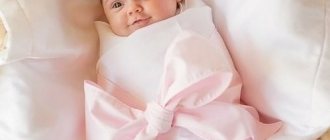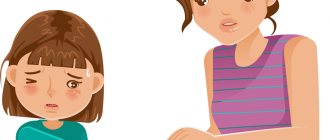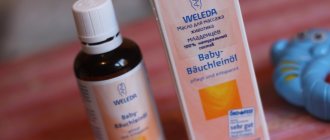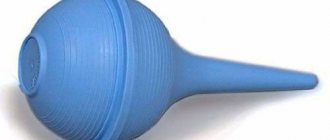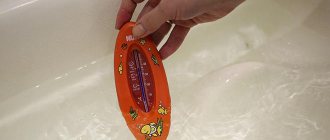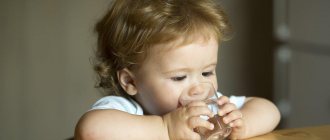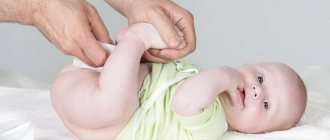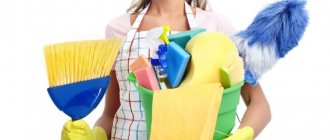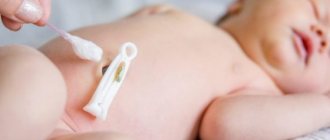08.10.2020 6669 0
The skin of a small child is very delicate and sensitive, and you need to care for it correctly to avoid skin diseases, diaper rash, dryness and other problems. This aspect should be given especially close attention: the child cannot yet say for himself what he needs, his body is just beginning to adapt to life. Therefore, proper skin care for a newborn is very important: use proven products, do not neglect skin care procedures, but also do not overuse. A happy and healthy baby is the most important thing for new parents.
Morning toilet of a newborn
Morning toileting for newborns is not just a symbolic process, but also a powerful obstacle to infection that can enter the child’s body from the outside. The skin of a newborn is more permeable to pathogenic microbes than that of adults, so you should always keep it clean.
Algorithm of actions for morning toileting of an infant
Every day the baby’s morning should begin with washing. Using a cotton swab, pre-moistened with boiled water, you need to gently wipe the baby's face with blotting movements. Using another cotton swab, wipe your eyes from the outer corner to the inner corner. Use a separate cotton pad for each eye. Then wipe the eyes with dry swabs.
Nose care
Next, roll flagella from cotton wool, soak them in boiled water or sterile vegetable oil and clean the baby’s nasal passages with gentle circular movements. Use a separate flagellum for each nostril.
Periodically, during the formation of crusts that complicate the child’s breathing, it is allowed to use special highly effective devices - suctions to cleanse the nasal sinuses. Do not use matches with cotton wool wrapped around them.
It is not recommended to use even cosmetic sticks to clean the nasal passages.
Intimate hygiene
The birth cavity of healthy babies does not need to be treated with anything. The child’s ear canals are cleaned no more than once a week with small cotton strands using the same method as the nose.
Then the child needs to be washed, and it doesn’t matter whether he had a bowel movement or not. To wash, use running water at a temperature of 36-37 degrees
Open the tap and adjust the water temperature, take the child in your left arm and place the lower part of his body under the running water. When washing, girls are held with their tummy up so that the water flows from the pubis to the anus.
Next, place the baby on a board or changing table and dry his skin with a napkin or soft diaper. Don't forget to work out the natural creases.
Treatment of skin folds in a newborn
The natural folds of the baby's body are lubricated with a cotton pad soaked in sterile vegetable oil or baby cream. It is also acceptable to use baby powder. You can only use one of the above options - combining the use of powder and oil is unacceptable.
The folds are lubricated, moving from top to bottom, in the following sequence:
- Behind the ears;
- On the neck;
- Axillary folds;
- Elbow folds;
- Folds near the hand (wrist);
- Popliteal folds;
- Folds near the foot (ankle);
- Inguinal folds;
- Folds in the buttocks area.
Caring for the navel and wound
Usually, a newborn is discharged home after the umbilical cord falls off, and therefore young mothers only have to treat the wound that remains in its place. In the first 2 weeks of life, in completely healthy babies, it may become wet. The umbilical wound can serve as a “gateway” for infection, so it requires special attention until it is completely healed.
To treat an umbilical wound you need:
- Sterile cotton swabs;
- 3% hydrogen peroxide solution;
- 1% alcohol solution of chlorophyllite (or 1% alcohol solution of green diamond);
- 70% ethyl alcohol solution.
Using the index finger and thumb of your left hand, you need to separate the edges of the umbilical wound and drop a few drops of a 3% peroxide solution onto it. Thoroughly “knead” the formed “foam” out of the wound with a clean cotton swab and then dry the wound with another one.
Use another sterile cotton swab with 70% ethyl alcohol and again, stretching the edges of the wound, treat them and the skin around the navel.
Using the fourth cotton swab dipped in a 1% chlorophyllite solution, treat the umbilical wound itself without touching the skin around it.
Any action in the process of performing the morning toilet should be accompanied by a gentle voice and a smile from the mother. In this case, the baby will perceive it as a game and a wonderful moment of communication with a loved one.
instructions: Morning toilet for a newborn.
How to properly wash a newborn
You will need cotton balls and flagella. We moisten everything in boiled water. We start with treating the eyes: rub the ball without pressing from the outer corner to the inner. Then wipe the outside of the nose with the ball and clean the inside of the nostrils with the flagellum. We treat the ears with a flagellum, removing wax from the skin of the external auditory canal. It is not worth pushing the flagellum deeper, since the wax is not removed, but is pushed inside the ear canal. It is enough to clean your ears 2 times a week. Wipe the skin behind the ears and face with a cotton ball. The umbilical wound should be treated 2 times a day with a 3% solution of hydrogen peroxide, then with brilliant green.
How to wash a newborn baby
Why and why? The skin of babies is much more delicate than that of adults, irritation and diaper rash occur very easily, so you need to wash the baby every time after he has had a bowel movement. In addition, keeping the skin clean helps your baby develop the first skills of neatness.
If you are away from home, you can use special baby wipes instead of washing, but you should not completely replace washing with such a simplified skin treatment.
A little trick. Babies tend to have a bowel movement after or during each feeding. This leads to the conclusion that washing before eating is a thankless task.
The first thing you need to do is roll up your sleeves, remove rings and watches from your hands, adjust the temperature and pressure of running water. Prepare a thin diaper to dry the skin after washing. It is very convenient to just hang it on your shoulder and always have it at hand. Unwaddle your baby and remove his diaper. It is more comfortable to hold the baby with your left hand and wash it with your right. The boy is held face down when washing. Take the baby so that his chest lies across your forearm, while you hold his shoulder with the fingers of your left hand. Oddly enough, but hanging in this position, the baby does not experience the slightest discomfort. The girl needs to be washed only from front to back, so as not to contaminate her genitals. Place the child's back on the forearm of your hand, so that the head is on the bend of the elbow, and you will hold her left thigh with your fingers. This position allows you to securely hold the baby, and leaves you complete “freedom of action.” Wash your baby by scooping water into your palm using gentle movements from top to bottom, carefully removing dirt from the skin.
It is especially important to wash all skin folds where dirt can accumulate and cause irritation. Do not use soap unless absolutely necessary; washing with soap once a week is sufficient. When washing a girl, there is no need to “rub” the genitals, since the mucous membrane is very delicate
In addition, overzealous washing removes the protective lubricant that protects the genitals from pathogens. After washing, dry your baby's skin. First, wrap the diaper over your baby's lower body and transfer him to the changing table. Then thoroughly blot the genitals, groin, buttocks and popliteal folds. If necessary (irritation), treat skin folds with a small amount of baby oil. Your baby is happy with life again. Now it would be good to “air out the butt” for 5-10 minutes before putting on a new diaper.
Prevention of eye inflammation in a newborn
There are a large number of medications and folk recipes that help prevent eye problems in infants. Before using any product, consult your pediatrician.
Treatment with Furacilin
An antibacterial drug is the best friend of mothers and their babies. It is a product for external use and effectively fights staphylococci, streptococci, E. coli, etc. Sold in the form of tablets or ready-made solution. For newborn babies, it is recommended to use a pharmaceutical preparation, since it is sterile.
To prepare at home, take one tablet of the drug per 100 milliliters of water. Heat the liquid over low heat and bring to a boil. Add the crushed tablet and wait until it is completely dissolved. Strain the prepared product and wipe the eyes with sterile gauze. The maximum shelf life of the solution is one day.
| Furacilin cannot be used as a preventive measure; it is intended specifically to combat diseases, and not to prevent them. Rub your eyes twice a day until complete recovery. |
Saline solution for rinsing
It is a weak solution of sodium chloride at a concentration of 0.9%. Everyone is familiar with this drug from an early age; it is used for droppers, diluting medications and treating the epidermis. Sold in almost every pharmacy.
The product has several undeniable advantages:
- Democratic price
- Does not cause an allergic reaction,
- Sold ready-made
- Effectively fights pathogenic microorganisms.
In pharmacies it can be found in the form of a large bottle or small plastic ampoules. To treat your baby's eyes, a couple of drops are enough; apply them to a cotton pad and wipe. The result is noticeable within a few days. The solution is safe for a child’s health; it is often used to remove debris or dust that accidentally gets into the eyes.
Phytotherapy
Decoctions and infusions of herbs are recommended for use as aids in the fight against sepsis. It is worth remembering that traditional medicine is powerless against inflammation caused by blockage of the tear ducts. But herbal medicine is effective in treating conjunctivitis.
Tea compress
The most popular “grandmother’s” way of dealing with suppuration. Eye compresses are prepared from strong black tea. They relieve irritation and soothe the baby's delicate skin. To prepare the composition, follow the following instructions:
- Buy loose leaf black tea without flavoring additives,
- Brew a strong drink and cool it to room temperature, let it brew for half an hour,
- Strain the tea
- Soak cotton swabs in the liquid, wring them out and place them on your eyes. Leave for ten minutes.
Camomile tea
Chamomile infusion is an effective “fighter” against inflammatory processes. It can be used as a prophylactic to prevent souring and suppuration of the eyes. To prepare the infusion you will need:
- Take 4 tbsp. dry chamomile (can be purchased at any pharmacy) and pour a glass of boiling water,
- Leave for one hour for the flowers to infuse,
- Strain the liquid.
Treat your child's eyes in the morning and evening while washing.
Calendula decoction
The plant helps stop the development of purulent sepsis. To prepare the infusion you need:
- 1 tbsp. pour the flowers into a small saucepan and add 400 ml of water,
- Cook for ten minutes, bring to a boil,
- Strain the finished infusion and cool to room temperature.
The decoction is used to prepare compresses or as an eye wash.
Attention! Calendula can provoke an allergic reaction (in rare cases), so before the procedure, do a test to check the sensitivity of your baby's skin. Place a small amount of the product on the elbow, if there is no redness, the drug can be used
Bathing a newborn
Why and why? Bathing a newborn (hygienic bath) is carried out for all healthy children after the umbilical remnant falls off. Before the umbilical wound heals, it is recommended to bathe the baby in boiled water or running water, but you need to add a solution of potassium permanganate (potassium permanganate) to it.
Until your baby is six months old, it is advisable to bathe him daily; in the second half of his life, you can do this every other day. As a rule, children really like to swim, because before birth, water was their natural element. In water, the muscles relax, the child feels comfortable and calm. The duration of bathing in the first year of life is 5-10 minutes. Washing with soap is carried out no more than once a week. It is advisable to bathe the child no earlier than an hour after feeding, preferably 10-15 minutes before evening feeding.
It is more convenient to bathe a newborn baby together; most often, the father is called upon to help, and in many families, bathing the baby is exclusively the father’s “honorable mission.” Large and reliable male hands hold the baby’s tiny body with amazing tenderness, which contributes to the emergence and development of close contact between the child and the father, who at these moments feels very needed. But if you have to do without an assistant, don’t worry, you can do it just fine on your own.
Important! If your baby is unwell, has a fever or signs of skin irritation, it is better to postpone bathing until you consult your pediatrician.
You will need: a baby bath, a jug of warm water for rinsing the baby, a special water thermometer, baby soap, a terry mitten, a large terry towel, a diaper, baby oil, a changing table with prepared clothes for the baby, cotton swabs with limiters or cotton swabs.
If the umbilical wound has not yet healed, prepare two containers with cold and hot boiled water or a solution of potassium permanganate to add to running water. The solution of potassium permanganate must be added to the water “drop by drop” until the water turns a faint pink color. Before using potassium permanganate, make sure that the crystals are completely dissolved, as getting a potassium permanganate crystal on the skin can cause a burn.
The air temperature in the room while bathing the child should be 22-24 degrees. You can bathe your baby in the bathroom, if it is spacious enough, or in the kitchen.
- First of all, you need to prepare the bath - wash with a brush and soap and rinse with boiling water. Place the bath in a stable, comfortable position and fill it ½ full with water. First pour cold and then hot water to avoid steam formation. Now you need to immerse the thermometer in water. The temperature of the water in the bath should be 37-37.5 degrees. Measuring the water temperature with your elbow is only possible if you have sufficient experience; a thermometer is always more reliable.
- Lay out the baby's clothes on the changing table, lay a towel on top, and place a diaper on it for wiping. However, you can put the diaper near the bath to make it more convenient for you to take it.
- Undress the child and, if necessary, wash him. Take the baby so that the head rests on the forearm of your left hand, and hold the baby’s left shoulder joint with your fingers (the thumb clasps the shoulder from above, place the other fingers in the armpit). Use your right hand to support the baby's buttocks and legs.
- Slowly immerse the baby in the bath: first the buttocks, then the legs and torso. Continue to support the baby's head with your left hand, leaving your right hand free for washing. The water level should reach the baby's armpits.
- Swing the child on the water back and forth, left and right. Your movements should be smooth and unhurried. Smile at your baby and talk to him affectionately.
- If you plan to wash the child with soap, then the “mitten” is put on the right hand. Lather your body using gentle circular motions and immediately rinse the soaped areas. First, wash your head from the forehead to the back of the head, then your neck, arms, chest, abdomen, legs. Rinse skin folds thoroughly. Lastly, wash your buttocks and genitals.
- Remove the baby from the water with its back facing up. Rinse your body and wash your baby's face with water from a jug. Place a diaper on the baby, place him on the changing table, and dry the skin with gentle blotting movements.
- Dry your ears with cotton swabs or cotton swabs.
- Lubricate the folds of the skin with baby oil. If necessary, treat the umbilical wound.
- Swaddle or dress your baby.
Now, to feel complete happiness, it would be nice for your baby to eat and sleep.
Means and equipment for washing a newborn baby
To carry out daily washing rituals, you will need to provide your child with personal hygiene equipment. All things, especially a towel, should be used exclusively by the baby and no other family members.
How long should a newborn baby sleep between feedings for up to a month?
You will need:
- cooled boiled water;
- small container (bowl or mug);
- baby or Vaseline oil;
- cotton swabs with a limiter;
- cotton pads (stored in closed containers);
- 3% hydrogen peroxide solution;
- salicylic alcohol or brilliant green;
- potassium permanganate solution;
- children's cosmetics;
- soft towel.
Before wiping a newborn’s face and other parts of the body, you need to prepare all the equipment and supplies. They are brought into the room and placed on the changing table, then they take the baby and begin the washing ritual.
On a note. For the first 3 months, children are washed exclusively with boiled water to minimize the child’s contact with harmful bacteria. You can then use warm tap or running water. It is recommended to periodically wash the baby with holy water against the evil eye.
Choose cosmetics very carefully, since children's skin is very thin and has blood vessels close to it. If there are no rashes, then the baby is washed exclusively with clean water. Children's or medicinal cosmetics are used in case of problem skin, in the presence of acne and irritation, and signs of allergies.
Memo for parents
Morning toileting causes stress in a child, but in order for the procedure to bring joy and calm to the baby, you need to know several important recommendations:
- Morning toilet should not be done on an empty stomach. The child must be well-fed, but this should not be done immediately after feeding. The best option is 30 minutes after eating.
- Hygiene procedures do not excite babies, especially the treatment of the sinuses, ears and eyes. To make the actions performed more enjoyable for the baby, parents need to sing a calm song or tell something interesting.
- The touches of adult hands should be gentle, light, soft. No sudden movements or screams are allowed, this can greatly frighten the baby.
- The most comfortable temperature in the room where morning toileting is carried out is from 21 to 23 degrees.
- After hygiene measures, a diaper is put on the lower part of the body, and a T-shirt or undershirt is put on the upper part. In this form, the child is placed in a crib for a while, only then fully dressed.
- You should not swaddle your baby too tightly, because in a clamped, non-physiological state, pathology in the development of joints may appear.
Daily care of the baby helps to prevent the development of various skin diseases in a timely manner and to do without any medications, because the morning toilet of a newborn is not only regular hygiene, it is also the prevention of pathological conditions.
The algorithm of actions is shown by the medical staff upon discharge from the maternity hospital; all procedures must be carried out correctly, and the baby must be examined thoroughly.
Purposes of application
Baby oils are universal:
- clean the nose and ears;
- remove crusts on the head;
- prevent and treat diaper rash after wearing diapers and in skin folds, relieve dry skin;
- facilitate massage.
Massage
Massage is a beneficial procedure for newborns. The mother establishes contact with the baby, at the same time the baby’s body relaxes and increased muscle tone disappears.
Baby massage
The most popular special means for these purposes are:
- "Eared Nanny";
- "Tender mother";
- "The world of childhood".
It is also permissible to apply Vaseline, peach or olive oil to the baby’s skin. These are products of natural origin that are well absorbed and moisturize the skin.
After swimming
After bathing, baby oil, cream, powder, lotion or milk are applied to the skin.
Comparison of the effects of products used after bathing
| Means | Action |
| Talc, powder | Prevention of heat rash and diaper rash. The skin becomes silky. First, talc is poured onto the palm of the parents, then the baby’s skin is treated with it. |
| Milk, lotion | Helps with flaking (especially on the palms and soles) and dry skin. The milk simultaneously moisturizes the skin and prevents moisture loss. |
| Baby cream | Excellent prevention against diaper rash. Creams with string and chamomile extracts perfectly soothe the skin. |
| Spray with panthenol | Helps in the fight against diaper rash and dry skin. |
| Oil | It is recommended to apply only when the skin is extremely dry. |
For dry skin
Baby bathing oil for dry skin helps restore the skin, saturates the skin with vitamins E and D, soothes and heals damaged skin. It should be applied immediately after bathing. Dry skin can be caused by improper care of your baby.
Rules:
- Do not bathe a newborn for more than 7-8 minutes;
- Do not wear one diaper for more than three hours, change immediately after defecation. Carry out air baths;
- Do not tear off the scabs on the baby's head under any circumstances - this will cause injury to the skin and increase the risk of infection.
Processing folds
Baby oil is an excellent product to soften the skin. It is very soft in the fold area. Treatment of folds is required every day.
For what purposes is the procedure carried out:
- prevent the appearance of diaper rash;
- to prevent skin from drying out;
- to clean hard-to-reach places from dirt and sweat;
- You can track the onset of an allergic reaction in time.
Oil is best suited for this procedure because it covers the skin with a film that protects it from the penetration of pathogenic microbes. The folds should be blotted carefully, without rubbing, so as not to cause irritation. At the end of the procedure, excess is removed with a napkin or cotton pad. Then the child is dressed in clean clothes, or the baby can be swaddled and put to rest.
Newborn skin problems
A crust on the head or the so-called “mom’s skin” is not a disease. To make it come off faster, lubricate it with Vaseline oil or baby cream, and during bathing, gently wipe it with a sterile gauze napkin.
To combat heat rash, monitor the temperature and do not overheat your child. You can combat its early manifestations with the help of normal hygiene, which was described above. If prickly heat does not go away, consult a doctor.
When diaper rash occurs, special attention is paid to skin care after each trip to the toilet. Let your baby’s skin “breathe” more often. Change diapers and diapers every few hours, even if they are dry. When changing them, it is necessary to wash the child. Or at least wipe with wet wipes.
